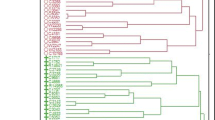Abstract
An elaborate version of the social subtyping system proposed by Wing and collaborators was examined in 58 children with a pervasive developmental disorder. Naive observers were able to reliably assign subjects into one of six subtypes on the basis of the behavior shown during a relatively unstructured playing session with a nonhandicapped peer. Subtypes were related to IQ, diagnosis (autism vs. PDD-NOS), severity of autism and several measures of social behavior, but were independent of sex and chronological age.
Similar content being viewed by others
REFERENCES
American Psychiatric Association (1987). Diagnostic and Statistical Manual of Mental Disorders (third edition, revised). Washington DC, Author.
American Psychiatric Association (1994). Diagnostic and Statistical Manual of Mental Disorders (fourth edition). Washington DC, Author.
Baltaxe, C. A. M., and Simmons, J. Q. (1983). Communication deficits in the adolescent and adult autistic. Seminars Speech Lang. 4: 27–42.
Borden, M. C., and Ollendick, T. H. (1994). An examination of the validity of social subtypes in autism. J. Aut. Devel. Dis. 24: 23–37.
Castelloe, P., and Dawson, G. (1993). Subclassification of children with autism and pervasive developmental disorder: A questionnaire based on Wing's Subgrouping scheme. J. Aut. Devel. Dis. 23: 229–241.
Cronbach, L. J., Gleser, G. C., Nanda, H., and Rajaratnam, N. (1972). The Dependability of Behavioral Measurements: Theory of Generalizability for Scores and Profiles, Wiley, New York.
Dewey, D., Lord, C., and Magill, J. (1988). Qualitative assessment of the effect of play materials in dyadic peer interaction of children with autism. Canad. J. Psychol. 42: 242–260.
Fleiss, J. L. (1981). Statistical Methods for Rates and Proportions (second edition), Wiley, New York.
Le Couteur, A., Rutter, M., Lord, C., Rios, P., Robertson, S., Holdgrafer, M., and McLennan, J. D. (1989). Autism Diagnostic Interview: A semi-structured interview for parents and caregivers of autistic persons. J. Aut. Devel. Dis. 19: 363–387.
Lord, C. (1984). The development of peer relations in children with autism. In Morrison, F. J., Lord, C., and Keating, D. P. (eds.), Advances in Applied Developmental Psychology, Academic Press, New York, pp. 165–229.
Lord, C., and Magill, J. (1989). Methodological and theoretical issues in studying peer-directed behavior and autism. In Dawson, G. (ed), Autism: Nature, Diagnosis, and Treatment, Guilford Press. New York, pp. 326–345.
O'Brien, S.K. (1996). The validity and reliability of the Wing Subgroups Questionnaire. J. Aut. Devel. Dis. 26: 321–335.
Prizant, B. M., and Schuler, A. L. (1987). Facilitating communication: Pre-language approaches. In Cohen, D. J., and Donnellan, A. M. (eds.), Handbook of Autism and Pervasive Developmental Disorders, Wiley, New York, pp. 316–332.
Roeyers, H., and Impens, K. (1993). Onderzoek naar de perspectiefnemings-vaardigheden van kinderen met autisme (Research into perspective taking abilities of children with autism). Tijdschrift Orthopedagogiek 32: 271–281.
Rutter, M., and Schopler, E. (1988). Autism and pervasive developmental disorders: Concepts and diagnostic issues. In Schopler, E., and Mesibov, G. B. (eds.), Diagnosis and Assessment in Autism, Plenum Press, New York, pp. 15–36.
Schopler, E., Reichler, R. J., and Renner, B. R. (1986). The Childhood Autism Rating Scale (CARS) for Diagnostic Screening and Classification of Autism, Irvington Publishers, New York.
Stutsman, R. (1948). Merrill-Palmer Scale of Mental Tests, Western Psychological Services, Los Angeles.
Volkmar, F. R., Bregman, J., Cohen, D. J., Hooks, M., and Stevenson, J. (1989). An examination of social typologies in autism. J. Am. Acad. Child Adol. Psychiatry, 28: 82–86.
Waterhouse, D., Morris, R., Allen, D., Dunn, M., Fein, D., Feinstein, C., Rapin, I., and Wing, L. (1996). Diagnosis and classification in autism. J. Aut. Devel. Dis. 26: 59–86.
Wechsler, D. (1967). Wechsler Preschool and Primary Scale for Intelligence (WPPSI), Psychological Corporation, New York.
Wechsler, D. (1974). Wechsler Intelligence Scale for Children-Revised (WISC-R), Psychological Corporation, New York.
Wing, L. (1981). Language, social, and cognitive impairments in autism and severe mental retardation. J. Aut. Devel. Dis. 11: 31–44.
Wing, L. (1988). The continuum of autistic characteristics. In Schopler, E., and Mesibov, G. B. (eds.), Diagnosis and Assessment in Autism, Plenum Press, New York pp. 91–110.
Wing, L., and Attwood, A. (1987). Syndromes of autism and atypical development. In Cohen, D. J., and Donnellan, A. M. (eds.), Handbook of Autism and Pervasive Developmental Disorders, Wiley, pp. 3–19.
Wing, L., and Gould, J. (1979). Severe impairments of social interaction and associated abnormalities in children: epidemiology and classification. J. Aut. Child. Schiz. 9: 11–29.
Author information
Authors and Affiliations
Rights and permissions
About this article
Cite this article
Roeyers, H. Subclassification of Children with a Pervasive Developmental Disorder: Assignment to Social Subtypes. Journal of Developmental and Physical Disabilities 9, 347–357 (1997). https://doi.org/10.1023/A:1024930028788
Issue Date:
DOI: https://doi.org/10.1023/A:1024930028788




